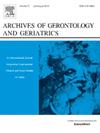老年人睡眠时间与虚弱之间的关系:观察性研究的系统回顾和荟萃分析
IF 3.8
3区 医学
Q2 GERIATRICS & GERONTOLOGY
引用次数: 0
摘要
目的探讨老年人睡眠时间长短与衰弱风险的关系。方法对PubMed、Web of Science、Embase和Scopus数据库进行系统检索,检索于2025年1月25日完成,重点关注60岁及以上成年人睡眠时间和虚弱风险的横断面研究、病例对照研究和队列研究。两位作者独立进行数据提取、质量评估和基于预定义标准的综合分析。随机效应模型用于估计综合效应大小和95%置信区间(ci)。I2统计量量化异质性,并通过亚组分析、元回归和敏感性分析来探索潜在的异质性来源,以验证结果的稳健性。定性方法用于描述无法定量分析的研究或效应大小。结果本系统综述共纳入15项研究。在老年人群中,据报道,短睡眠者(7小时)中虚弱的患病率为15%,长睡眠者(8小时)中虚弱的患病率为22%。短睡眠时间(7小时)与虚弱患病率之间存在显著相关性(OR1.44, 95% CI1.22 - 1.67),长睡眠时间(OR 1.96, 95% CI 1.52-2.52)与虚弱患病率之间存在显著相关性。结论老年人的身体虚弱与睡眠时间有关。与那些睡眠时间正常的人相比,短睡眠者和长睡眠者都表现出更高的虚弱患病率。本文章由计算机程序翻译,如有差异,请以英文原文为准。
Association between sleep duration and frailty in older adults: Systematic review and meta-analysis of observational studies
Objective
To assess the relationship between short, and long sleep duration and the risk of frailty in older adults.
Methods
We conducted a systematic search of the PubMed, Web of Science, Embase, and Scopus databases, with the search completed on January 25, 2025, focusing on cross-sectional studies, case-control studies, and cohort studies regarding sleep duration and frailty risk in adults aged 60 and older. Two authors independently performed data extraction, quality assessment, and comprehensive analysis based on predefined criteria. A random effects model was used to estimate the combined effect size and 95 % confidence intervals (CIs). The I2 statistic quantifies heterogeneity and explores potential sources of heterogeneity through subgroup analysis, meta-regression, and sensitivity analysis to validate the robustness of the results. A qualitative approach was used to describe studies or effect sizes that could not be analyzed quantitatively.
Results
This systematic review included a total of fifteen studies. In the elderly population, the prevalence of frailty was reported as 15 % among short sleepers (<7 h) and 22 % among long sleepers (>8 h). There was a significant association between short sleep duration(<7 h) and frailty prevalence (OR1.44,95 %CI1.22–1.67), as well as a significant association between long sleep duration (>8 h) and frailty prevalence (OR 1.96, 95 %CI 1.52–2.52).
Conclusion
In the elderly population, frailty is associated with sleep duration. Compared with those with normal sleep duration, both short and long sleepers exhibit a higher prevalence of frailty.
求助全文
通过发布文献求助,成功后即可免费获取论文全文。
去求助
来源期刊
CiteScore
7.30
自引率
5.00%
发文量
198
审稿时长
16 days
期刊介绍:
Archives of Gerontology and Geriatrics provides a medium for the publication of papers from the fields of experimental gerontology and clinical and social geriatrics. The principal aim of the journal is to facilitate the exchange of information between specialists in these three fields of gerontological research. Experimental papers dealing with the basic mechanisms of aging at molecular, cellular, tissue or organ levels will be published.
Clinical papers will be accepted if they provide sufficiently new information or are of fundamental importance for the knowledge of human aging. Purely descriptive clinical papers will be accepted only if the results permit further interpretation. Papers dealing with anti-aging pharmacological preparations in humans are welcome. Papers on the social aspects of geriatrics will be accepted if they are of general interest regarding the epidemiology of aging and the efficiency and working methods of the social organizations for the health care of the elderly.

 求助内容:
求助内容: 应助结果提醒方式:
应助结果提醒方式:


